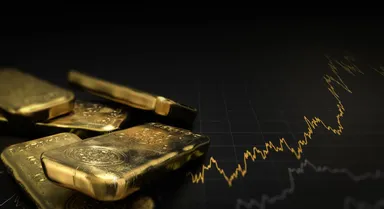Gold
Gold is a lustrous precious metal with many unique properties. It is attractive in colour and brightness, highly malleable, durable and usually found in nature in a relatively pure form. Appreciated far beyond its industrial usage, gold is one of the most widely-traded metal commodities.
Gold has a lower correlation to many asset classes, making it a widely used tool for diversification. Over the decades, the metal has attracted international investors keen to balance their portfolio and hedge against any financial uncertainty, inflation, deflation or currency devaluation. Compared to other precious metals used for investment, gold has the most effective safe haven properties across a number of countries.
Like most commodities, the gold spot price is driven by the laws of supply and demand.
Gold deposits are rare and difficult to find, making its extraction from mines a time-consuming and expensive activity. China, Australia, Russia, the US, Canada, Indonesia, Peru and South Africa are the world’s largest producers of the metal.
However, most of the gold ever mined still exists in an accessible form, such as jewellery or bullion, and can be brought back onto the market. Given the large quantity of the metal stored above ground compared to its annual production, the gold price is mainly affected by changes in sentiment, which, in turn, influences market supply and demand accordingly.
The gold market is subject to speculation and volatility as any other market. The demand for jewellery is fairly constant. However, economic downturns may lead to some temporary reductions in demand from this industry.
Trade Gold Spot (Gold) CFDs
Gold Spot (ticker: Gold) is a commodity market instrument that reflects the price of a specific raw material or natural resource. On Capital.com, it can be traded as a contract for difference (CFD) which lets you speculate on price changes without taking ownership of the physical asset. This means you can go long or short depending on how you think the market will move.*
Many traders follow the Gold Spot price today to stay alert to short-term shifts in market sentiment.
*CFDs are traded on margin. Leverage amplifies both profits and losses.
Gold Spot price today
The instrument is quoted in $ and is currently trading around 4736.89.
Live price overview
Below is an overview of the current Gold Spot price and its recent trading ranges.
- Daily range: 4659.43 – 4731.5
- Daily movement: +58.6 (+1.2546%)
- Weekly range: 4536.65 – 4731.5
- Monthly range: 4274.05 – 4731.5
- Yearly range: 2689.21 – 4731.5
Why trade commodity CFDs on the price of Gold Spot with Capital.com?
Capital.com provides tools and features designed to support informed decision-making when analysing live market prices.
Advanced charting and analysis
Use interactive tools to study the Gold Spot price chart in detail.
- Access 100+ technical indicators
- Choose from 12 chart types
- Analyse fast, interactive charting tools
Wide market offering
Join over 798 global traders and explore a wide range of markets:
- 4,000 stock CFDs
- 60 commodity CFDs
- 30 index CFDs
- 120 forex pairs
User-rated platforms
- TradingView rating: 4.8
- App Store rating: 4.7
- Google Play rating: 4.6
- Trustpilot score: 4.6
What influences the price of Gold Spot?
The Gold Spot (Gold) price may be influenced by several market factors, including:
- Supply and demand dynamics
- Global economic conditions
- Geopolitical events affecting production or transport
- Seasonal trends
- Market sentiment and risk appetite
- Currency fluctuations
These factors can interact in complex ways, contributing to both short-term movements and longer-term trends.
Gold Spot price forecasts
Gold Spot price forecasts commonly reference recent news, company updates, and broader economic factors rather than fixed price targets. You can use a combination of technical analysis and fundamental insights to form a view of potential future price movements. However, analyst forecasts are often inaccurate and past performance is not a reliable indicator of future results.
Instead of relying on a single outlook, some traders monitor ongoing analysis and real-time data to respond to changing market conditions.
How to trade Gold Spot commodity CFDs
With CFDs, you can trade without owning the underlying physical commodity:
- Go long (buy) if you expect prices to rise
- Go short (sell) if you expect prices to fall
Leverage allows increased exposure but also magnifies losses.
Risks of trading commodity CFDs
Key risks include:
- High market volatility
- Leverage amplifying both losses and gains
- Funding costs for holding positions overnight
- No ownership of the underlying commodity
Latest commodities articles



